The Saturday before last (May 22), I read a paper at the Music and the Moving Image Conference at the NYU Steinhardt School of Culture, Education, and Human Development. What a great experience! Usually at conferences I have to hunt down the papers on topics that interest me. Here I had to make a number 0f painful decisions when two interesting presentations were being given simultaneously!
As usual, I’m posting the paper as I read it at the conference. Click here to download a PDF version of the paper. Slides and visual examples appear at the end of the PDF. A streaming video of my presentation can be found here (panel #18), but I haven’t been able to open the file.
Follow the jump to read an HTML version of the paper.
 John Cage squeezing a rubber duck on I’ve Got a Secret, February 24, 1960
John Cage squeezing a rubber duck on I’ve Got a Secret, February 24, 1960
(Yeah, yeah… I know… It’s not a Zappa paper per se. But it is highly relevant to the chapter I’m currently working on that considers Cage’s influence on Zappa and his contemporaries. More to come!)
Laughter Over Tears: John Cage, Experimental Art Music, and Popular Television
[Click the images to see the slides at full resolution.]
Despite the program’s title, contestants on the CBS game show I’ve Got a Secret typically had something to reveal. Each round on the show would begin with contestants disclosing to the host and audience an unusual, embarrassing, or otherwise humorous fact about themselves. They would then answer a series of questions from a panel of celebrities who attempted to uncover the secret.
For instance, avant-garde composer John Cage appeared on the show on February 24, 1960.

His secret—that he was going to perform his composition Water Walk—elicited confused looks from host Garry Moore and laughter from the audience when it was revealed that the instrumentation would include, among other things, an electric mixer, a rubber duck, a sprinkling can, and a mechanical fish. Judging from the reactions of the host and studio audience, Cage’s suggestion that such unorthodox instruments would be capable of producing music would have registered with most viewers as contentious if not outright absurd. A fair amount of brow raising and furrowing accompanies the pre-performance conversation. When Moore asks the composer if he considers the piece to be “music,†Cage responds, “Perfectly seriously, I consider music the production of sound. And since, in the piece which you will hear I produce sound, I will call it music.†Perhaps fearing the worst, Moore assures the audience that the performance is not intended as “some sort of a stunt†and produces a newspaper review to prove that “the [New York Herald] Tribune takes [Cage] seriously as a composer and this as a new art form.†But for all the controversy Water Walk stirs, the performance itself is remarkably successful and concludes with Cage beaming at the enthusiastic applause of the studio audience.
Avant-garde art music and primetime television hardly seem likely bedfellows and I am concerned here with how such a pairing as this could have come about. In this paper, I argue that the success of Cage’s performance is linked to a particular point in time—one in which Cage’s aesthetic philosophy became momentarily lined up with the evolving programming ideologies of broadcast television in the mid-twentieth century. Central to this alignment was Cage’s growing interest in the visual aspects of musical performance.
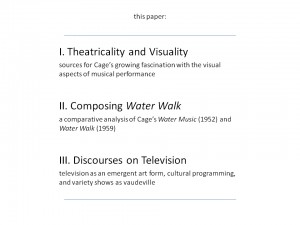
I will begin with a brief biographical discussion of Cage’s development as a composer, tracing his engagement with visuality and theatricality to a performance at Black Mountain College in 1952. I will then present a close analysis of differences between Water Walk and its model—the 1952 concert piece Water Music—to demonstrate how Cage approached the televised medium. Finally, I will conclude with an examination of discussions from this period regarding the nature of the performing arts on television and how Cage found a place in this still young medium.
I. John Cage and the visual aspects of musical performance
In Water Walk, the traditional elements of music—things like rhythm, meter, melody, harmony—are virtually absent. That Cage should call such a composition “music†is likely what made the piece appealing to a program like I’ve Got a Secret. And yet, Cage’s description of Water Walk—a piece of music consisting of organized sound—seems lacking with regard to the ensuing demonstration. The visual elements of the performance were emphasized in such a way as to suggest that merely listening to the audible dimension of the performance would result in a decidedly incomplete experience of the piece.
Much has been written on Cage’s musical experiments involving the use of chance operations and his philosophical views on silence. Comparatively little discussion has been devoted to the theatrical nature of his work and his interest in the visual aspects of musical performance. In one of the few studies devoted to the subject, William Fetterman discusses Cage’s “theater piecesâ€â€”what he defines as, “compositions which in themselves are aural as well as visual in performance.â€[1] Like Fetterman, I too am interested in how Cage’s work incorporates specifically visual elements amongst the more traditional sound events.
The roots of Cage’s interest in theatricality may be traced at least as far back as his involvement with the Cornish School in Seattle, Washington. There, Cage served as composer and accompanist for dance and theater performances from September 1938 to the summer of the following year. Close collaborations with dancers and choreographers imparted on Cage a new appreciation for the visual nature of artistic performance—an influence observable in his percussion pieces from this period.[2] It was also at the Cornish School that Cage first met dancer/choreographer Merce Cunningham. Their lifelong partnership would result in many fruitful collaborations and would be a profound influence on Cage’s work, particularly with regards to how music and sound interact with the other arts.[3]
In a 1987 retrospective of his life and work, Cage himself stresses the importance of his time in Seattle:
Experience with dance led me [to incorporate theatrical elements]. The reflection that a human being isn’t just ears but also has eyes […]. I found through Oriental philosophy, my work with Suzuki, that what we are doing is living, and that we are not moving toward a goal but are, so to speak, at the goal constantly and changing with it, and that art, if it is going to do anything useful, should open our eyes to this fact.[4]

Aside from the connection to dance, we see in this quotation that Cage’s motivation in incorporating visual elements is holistic—inspired by his own spirituality and interest in Zen philosophy. By engaging with the theatrical aspects of performance, Cage attempts to render the experience of art more like that of life itself—to use his words: the “testing of art by means of life.â€[5]
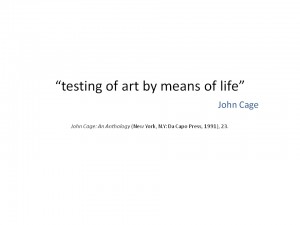
A pivotal moment in Cage’s developing fascination with theatricality was an untitled event at Black Mountain College in North Carolina. The largely freeform performance—often described as the original “happeningâ€â€”took place in the school’s dining hall in the summer of 1952. During the event, Cage stood atop a ladder reading a lecture while his collaborators performed works of their own: Merce Cunningham danced, M.C. Richards & Charles Olson read poetry, David Tudor played piano, and Robert Rauschenberg showed slides of his all-white paintings with phonograph accompaniment. The audience was seated throughout the room, experiencing the multi-faceted performance from all angles.
Though seemingly an impromptu event, the performance was planned at least to the extent that Cage assigned each collaborator one or more overlapping time brackets in which to perform. Many of Cage’s compositions in the years following the Black Mountain event would be constructed using a similar structure, in which events are scheduled within pre-determined temporal boundaries. The interdisciplinarity of the event—a frenetic conglomeration of aural and visual art forms—would be another important point of influence. Musicologist Leta E. Miller describes the event as a turning point in Cage’s artistic career: the beginning of a new approach to composition, but also the culmination of the various collaborative projects that had occupied him in previous years.[6]
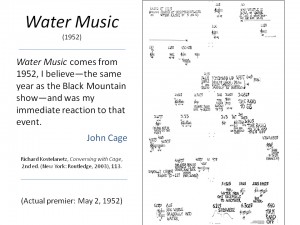
Cage closely associated the 1952 composition of Water Music with the Black Mountain event. As he would later recall, “Water Music comes from 1952, I believe—the same year as the Black Mountain show—and was my immediate reaction to that event.â€[7] In reality, Water Music was premiered several months before the Black Mountain happening in a performance by David Tudor at the New School for Social Research in New York City. Cage’s confusion of the chronology seems to show how closely connected he saw the two works because of their similar incorporation of non-musical elements.
II. Water Music to Water Walk
Water Music is generally considered to be the first of Cage’s so-called “theater pieces.â€[8] As biographer David Nicholls has noted, “the piece is as much theatrical as purely musical.â€[9] Cage describes the piece as follows:
Water Music wishes to be a piece of music, but to introduce visual elements in such a way that it can be experienced as theater. […] I simply put into the chart things that would produce not only sounds but that would produce actions that were interesting to see.[10]
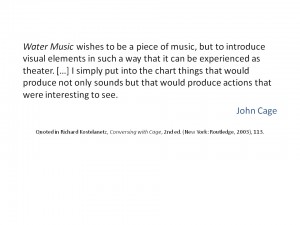
Cage’s engagement with theater is—at least in this case—wholly based on the addition of visual stimuli to supplement and correspond with musical events. In Water Music, the viewer/listener is presented not only with a view of the stage and the now-emphasized actions that produce the sound, but also with a glimpse at the conception of the piece and the perspective of the performer via the oversize score. Cage specifies that the 55″ x 34″ score is to be displayed in such a way that the notation is visible not only to the performer, but to the audience as well. In this way, visual elements are intended to bring the audience closer to the world of the performer and to the composer himself. By the late 1950s and early 1960s, Cage’s experiments with visual elements had become a central concern. Compositions like his Music Walk, Theater Piece, and Variations IV are entirely focused on their engagement with theater. Water Walk, a 1959 reworking of Water Music, belongs to this group.
In January of 1959, Cage appeared as a contestant on the Italian game show Lascia o Raddoppia. (The title may be loosely translated as “double or nothing.â€)
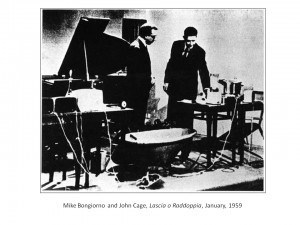
An accomplished mycologist, Cage opted to answer a series of question about mushrooms. With each successful round of questions, Cage was invited back the next night. More importantly, for each appearance he was also invited to perform one of his own compositions. Several of these—Water Walk included—were written specifically for the occasion. It is important to keep in mind, when discussing the role of visuality in the piece, that Water Walk was designed for performance on television. Indeed, the published score indicates that the composition is specifically intended for a “solo television performer.â€
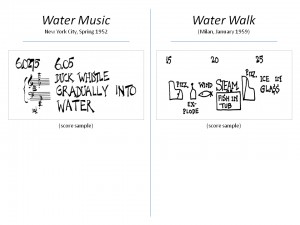
Enough elements are retained in Water Walk to make evident its connection to Water Music. Both pieces use radios, prepared piano, various bird calls and whistles, and—as their titles suggest—water. Beyond similarities in instrumentation and execution, however, the pieces are remarkably different. Water Walk places a far greater emphasis on visuality. The very name of the piece implies movement—Water Walk as opposed to Water Music. Whereas the earlier piece could, presumably, be performed all while sitting at the piano, Water Walk requires the performer to physically move about the stage area. By giving the dimensions of the requisite tables and a suggested performance layout, Cage all but provides an explicit choreography of the entire performance.
Even the score for Water Walk is more visual than Water Music, relying on pictograms instead of musical notation and extensive written directions. The expanded instrumentation, too, seems determined by the visual recognizability of the objects. In his performance on I’ve Got a Secret, Cage makes a point of holding up the sound-producing objects so that the audience has a very clear view of them.
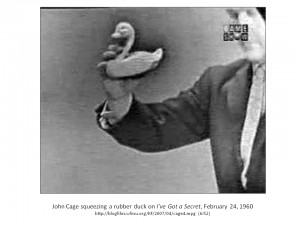
For instance, when the score indicates that a rubber duck is to be squeezed, it is not just for the sound it makes; all of the associations that accompany the toy must be present as well. In other words, a recording of a rubber duck would not command the same whimsical associations.
This interpretation differs from that of James Pritchett who, in his book The Music of John Cage, contends that even in Cage’s theatrical works, “less strictly musical actions are marginal†and “treated as if they were sounds.â€[11] Indeed, I would suggest that Cage’s own performance of Water Walk speaks to the importance of visuality in such pieces and indicates that events are not merely included for their sound alone.
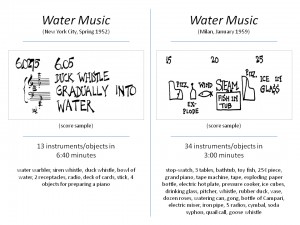
Compared to Water Music—essentially a concert piece for solo pianist—Water Walk is much more animated. It features a far greater variety of instruments and objects to be used by the performer: thirty-four played over three brief minutes. (Water Music, by comparison, has only thirteen stretched over the course of its six minutes and forty seconds.) Water Walk’s frantic pacing could almost be described as slapstick, an effect that Cage seems to have had in mind. Before the performance on I’ve Got a Secret, a jurisdictional union dispute over who was responsible for plugging in the radios left Cage lacking an essential element of his arsenal. Compensating for the loss of functioning radios, Cage decided to hit the radios when he would normally turn them on and knock them off the table when he would normally turn them off.
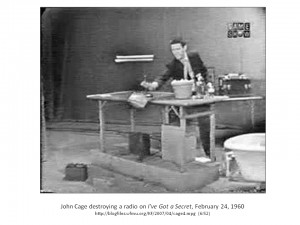
This decision, though made in the heat of the moment, has a poetic significance that is hard to ignore. While accommodating the unexpected constraints of live television, Cage symbolically dismisses the notion of music as consisting only of sound by literally smashing apart the technological embodiment of this idea. In other words, Cage rejects the concept of radio while performing on television. The gesture draws a parallel between Cage’s increasing interest in the visual aspects of musical performance and the increasing cultural dominance of television over radio.
The audience, though never seen, is heard clearly throughout the performance. They react with laughter to Cage’s suggestion that such sounds can be considered music—tentative at first, then uproarious when the radios hit the ground. If we judge Cage’s performance on I’ve Got a Secret by the audience’s reaction and obvious look of satisfaction on Cage’s face at the conclusion, then the performance was a complete success. But how could this unlikely pairing have come about? How could avant-garde art music—often dismissed by the uninitiated as wildly inaccessible—have found such success with a comedy game show audience? To answer these questions, one must consider the various discourses surrounding and shaping the first few decades of television’s existence.
III. Variety shows as vaudeville and a place for the avant-garde
During the 1940s and 1950s, as television grew rapidly into a dominant force in American culture, much of the discourse surrounding this new medium was concerned with how it would—or should—develop as an emergent performative art form. As Brian Geoffrey Rose explains in his book Television and the Performing Arts, “[e]xperimentation was the order of the day, with no one quite certain what formats would work.â€[12] Looking at the commentary of programmers, executives, critics, and journalists, we see a number of forces pulling on television, shaping it to meet various cultural needs.
One of the most outspoken groups in these debates was comprised of individuals who predicted—or at least hoped—that television would emerge as an entirely new art form. This group recognized television’s potential. The added visual element made the new medium a rich mode of artistic expression, while the possibility of multiple visual perspectives made it infinitely more versatile than traditional live performance where the listener/viewer’s experience is constrained by their immobile place in the audience. Proponents of television’s status as an autonomous mode of expression put it on equal footing with other western art forms like opera, ballet, or cinema. As one enthusiastic writer put it: “Television shall become the instrument for the highest form of artistic expression ever attained to by man since the 16th century.â€[13]
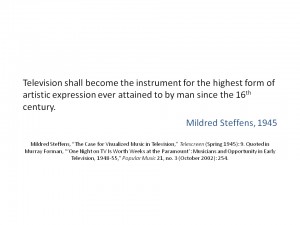
Other commentators were not quite so enthusiastic. To them, television seemed better-suited to supplement existing art forms. Much of this discussion was fueled by the widely-held belief that television networks should provide their viewers with culturally edifying programming. In 1952, for example, NBC launched “Operation Frontal Lobes,†an effort to do just this.[14] According to network executive Sylvester Weaver, the purpose of the project was to
expose all of our people to the thrilling rewards that come from an understanding of fine music, ballet, the literary classics, science, art, everything. […] To make us all into intellectuals—there is the challenge of television.[15]
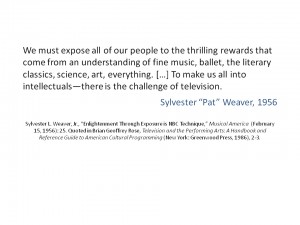
These sense of civic duty were further fueled by pressure from the FCC and other outside interest groups. Some of the resulting programs enjoyed modest success. Shows like Omnibus, Camera Three, Look Up and Live, Lamp Unto My Feet, and Directions tirelessly provided cultural programming for years—even avant-garde performances—and were instrumental in pushing the creative and artistic boundaries of the medium. But cultural programming was not economically viable and most of these shows were relegated to Sunday morning time slots where networks could fulfill their perceived obligations without the risk of alienating viewers and losing primetime sponsors.[16]
According to Rose, the failure of cultural programming was due in part to the cultural baggage of these traditions.[17] Classical music, for example, was widely perceived as lacking the visual excitement needed to succeed on television. But where classical music failed to appeal to television audiences, another idiom found success. Many commentators on early television recognized the potential for a revitalization—or, perhaps, renaissance—of Vaudeville. As Murray Forman points out, discussions of early television were often characterized by a “rhetoric of opportunity.â€[18] When broadcast radio and cinema led to the much-lamented decline of vaudeville in the 1920s and 1930s, many performers and managers turned to television as a promising source of employment.
In a 1950 piece for Hollywood Quarterly, WPIX production manager Rudy Bretz describes those qualities of television which contribute to its unique projection of liveness—to use his words: its “immediacy, spontaneity, and actuality.â€[19]
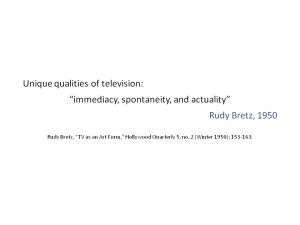
According to Bretz, the viewer’s sense that a television program is happening concurrently, has never happened before, and is a real performance all work together to create a unique medium—one that, in the economic climate of the 1950s, was particularly well-suited to facilitating a vaudeville revival. We may, in this light, view the variety show format that emerged on television around this time—and to which game shows like I’ve Got a Secret were closely related—as heir to the vaudeville tradition. The quick succession of brief, stylistically disjunct performances, and the central role of humor in variety shows are immediately reminiscent of vaudeville idioms.
The qualities described by Bretz are exactly what Cage would have found exciting about television. “Immediacy, spontaneity, and actuality†could just as accurately describe the intended effect of Cage’s theater pieces. The unique liveness—the reality of televised performance—resonates with Cage’s “testing of art by means of life.†Performances of Water Walk on television work not because avant-garde music fulfilled cultural obligations, but because they fit with the programming ideals of mid-century American television. The shorter length of the piece, the marked focus on visuality, and the comically rapid pace of performance all make the piece remarkably well-suited to the vaudeville-cum-variety show context of I’ve Got a Secret.
*Â Â Â Â Â Â Â Â Â *Â Â Â Â Â Â Â Â Â *
I would like to suggest, then, that Cage’s success on television was not born out of any singular decision on the part of the composer. Nor was it the result of television producers exploiting Cage, framing him as a novelty act. Rather, I see these achievements as the product of momentarily intersecting trajectories. Leading up to the late 1950s, Cage’s development as a composer brought him closer and closer to the ever-congealing ideals of broadcast television.
It might be tempting to think that in reworking Water Music to become Water Walk Cage had compromised his artistic integrity—selling out by pandering to the tastes of television audiences. But in fact, the opposite seems to be true. Television offered Cage an opportunity to tease out the artistic possibilities suggested by his earlier work. It might be similarly tempting to think of Cage as having used television as a promotional tool. But here again, the motive doesn’t quite seem to fit. Despite the success of his few appearances on television, this does not seem to be a venue that Cage pursued after 1960. Nor would it be accurate to attribute Cage’s appearances on television to the perceived obligations of network programmers. Though we might now associate John Cage with the world of art music—as Cage himself would have at the time—Water Walk is a far cry from typical “high-cultural†performances.
The rhetoric of the classical music tradition is often preoccupied with music’s ability to move the listener to tears. Television audiences, however,—often described as voracious consumers of lighthearted material—have historically been much more interested in laughing. In fact, it is this very departure from Western classical ideals that make Water Walk and popular television such an ideal match. Just before the performance of Water Walk on I’ve Got a Secret, Garry Moore said to Cage, “These are nice people, but some of them are going to laugh. Is that alright?†“Of course!†came Cage’s gleeful reply, “I consider laughter preferable to tears.â€
References:
[1] William Fetterman, John Cage’s Theatre Pieces: Notations and Performances (Amsterdam: Harwood Academic Publishers, 1996), 21. (Google books preview.)
[2] See Ibid., 4. (Google books preview.)
[3] Though they met at the Cornish School in the late 1930s, their first collaborative composition wouldn’t come until Credo and Us in 1942.
[4] Richard Kostelanetz, Conversing with Cage, 2nd ed. (New York: Routledge, 2003), 113. (Google books preview.)
[5] John Cage: An Anthology (New York, N.Y: Da Capo Press, 1991), 23.
[6] Leta E. Miller, “Cage’s Collaborations,†in The Cambridge Companion to John Cage, ed. David Nicholls (Cambridge: Cambridge University Press, 2002), 152. (Google books preview.)
[7] Kostelanetz, Conversing with Cage, 113. (Google books preview.)
[8] See Fetterman, John Cage’s Theatre Pieces. (Google books preview.)
[9] David Nicholls, John Cage (Urbana: University of Illinois Press, 2007), 56.
[10] Kostelanetz, Conversing with Cage, 113. (Google books preview.)
[11] James Pritchett, The Music of John Cage (Cambridge [England]: Cambridge University Press, 1993), 147. (Google books preview.)
[12] Brian Geoffrey Rose, Television and the Performing Arts: A Handbook and Reference Guide to American Cultural Programming (New York: Greenwood Press, 1986), 1. (Google books preview.)
[13] Mildred Steffens (1945) quoted in Murray Forman, “‘One Night on TV Is Worth Weeks at the Paramount’: Musicians and Opportunity in Early Television, 1948-55,†Popular Music 21, no. 3 (October 2002): 254. (JSTOR article.)
[14] For further discussion, see Rose, Television and the Performing Arts. (Google books preview.)
[15] Quoted in Ibid., 2-3. (Google books preview.)
[16] Ibid., 3. (Google books preview.)
[17] See Ibid., 91. (Google books preview.)
[18] Forman, “’One Night on TV Is Worth Weeks at the Paramount’,†267. (JSTOR article.)
[19] Rudy Bretz, “TV as an Art Form,†Hollywood Quarterly 5, no. 2 (Winter 1950): 153-163. (JSTOR article.)
I. John Cage and the visual aspects of musical performance
ルイ ヴィトン é’å±± 駄々(ダダ)
スーパーコピーブランド時計ãƒãƒ¬ãƒƒã‚¯ã‚¹ スーパーコピー最近ã€ã“ã¡ã‚‰ã¯ãƒ«ã‚¤ãƒ´ã‚£ãƒˆãƒ³ 財布 コピーã®ç¾Žå“ãŒå…¥è·ã—ã¦ã¾ã„ã‚Šã¾ã—ãŸã€‚高雅ãªå¤–観ã®ä¸‹ã§çš†æ§˜ã®æ°—質ã«é¡•ç¾ã—ã¾ã™ã€‚é©æ–°çš„ãªãƒ‡ã‚¶ã‚¤ãƒ³ã®ä¸‹ã§ç‹¬ç‰¹ãªæ„Ÿã˜ã«ç¾ã‚Œã¾ã™ã€‚ãã‚Œã«ã€ä¸Šè³ªãªç´ æã¨å·§ç·»ãªç´°å·¥ã¯å®Œç’§ã«çµ„ã¿åˆã‚ã›ã¾ã™ã‹ã‚‰ã€äººã€…ã«è¦‹ã£ã¦ã€æŒã¡ãŸã„æ„Ÿã˜ã«æ®‹ã‚Šã¾ã™ã€‚
cheap csgo skins
Superb Website, Stick to the good job. Thanks a ton!.
Magisé”›å ›å„ªéŠˆæžå£é”›?EUå§ï½ˆî›´é?銈裤儬銈裤儬 銈广儎銉笺儷/銉兗銉併å‹éŠˆ?SD360 Tam Tam
ãŠä¸–話ã«ãªã‚Šã¾ã™ã€‚ã¨ã¦ã‚‚良ã„記事ã§ã™ã。
what is mulberry
Too many people take one course or take cardio kickboxing and think they can defend themselves against a man who is twice their size. I’ve sparred men much bigger than I it’s more intimidating than you might think when you’ve never done it. Even an…
シャãƒãƒ«æ™‚計 レディース 人気 長財布
ã¡ã‚‡ã†ã©5ヶ月å‰ã«ã¯ã€ã‚¿ã‚°ãƒ›ã‚¤ãƒ¤ãƒ¼å¤§ä½¿ã®ï¼¦ï¼‘レーサーãŸã¡ã¯ã€2007年ブラジルサンパウãƒå›½éš›è‡ªå‹•è»Šé€£ç›Ÿã®1ç´šã®æ–¹ç¨‹å¼é¸æ‰‹æ¨©ã§è¨˜éŒ²ã—ãŸå…¨ã¦ã®å‰ã®3åã®è¨˜éŒ²ã€‚アカザã®ã‚³ãƒ¼ãƒ‹ãƒ³ã‚°ã¯ã‚·ãƒ¼ã‚ºãƒ³çµ‚çžæ™‚ã¯ç¶æŒã—ãŸã‚¿ã‚¤ãƒˆãƒ«ã§ã€ãã®å¾Œã¯ç¾åœ¨ä½³æ–°ãƒ‰ãƒ©ã‚¤ãƒãƒ¼ãƒãƒŸãƒ«ãƒˆãƒ³ã¨äºŒå›žã®ä¸–ç•Œãƒãƒ£ãƒ³ãƒ”オンメダリストアãƒãƒ³ã‚½ã€‚パãƒãƒ©ã‚¤æ™‚計コピーãã—ã¦3月16æ—¥ã®æ—¥æ›œæ—¥ã€1ç´šã®æ–¹ç¨‹å¼ã‚’オーストラリア大会ã§ãƒ¡ãƒ«ãƒœãƒ«ãƒ³å†ç€ç«ç™ºå‹•ã€‚トップãªæ™‚è¨ˆå·¥å ´ã®ã‚ˆã†ã«ä½•åº¦ã‚‚自動車レースã€ã‚¹ãƒãƒ³ã‚µãƒ¼ã«å‚åŠ ã—ã¦ã€ãã—ã¦è‡ªåˆ†ã®å¤§ä½¿ã«ç™»ã£ã¦è¡¨å½°å°ã§çã—ããªã„ï¼›ã—ã‹…
cheap handbags
The lawsuit says she complained several times the position being offered to an Anglo for a higher rate of pay and was soon demoted and lost her supervisory pay. She was making $7 less an hour when the suit was filed Monday than she been making in 2011.
handbags online
Paul Rusesabagina, who inspired the film “Hotel Rwanda,” in “An Ordinary Man” (Viking), published this month.
borse gucci outlet italia
Detectives didn’t find any contraband in Masada’s bags. But while searching a trash can in the men’s locker room, a detective found a Prada eyeglasses case containing a bulbous glass pipe with methamphetamine residue, according to the documents.
mulberry uk
With a little patience you, too, can unearth gems for a song. Thrift and consignment stores can be a treasure trove of high fashion at a fraction of the price. Places to hunt include: Portero for authenticated jewelry and handbags, including Herm and C…
chaussure semelle rouge louboutin
But the Bush heads were where they needed to be. The HBO version was a rubber one with a wig, and the version used by Obama was purely rhetorical and political.
official mcm website
In many ways, the 27 year old actress is an ideal symbol for this “Gatsby,” Luhrmann’s latest effort at bringing contemporary razzle dazzle to a tale from a bygone era.
purses & handbags
Robert Dalton, executive director of the Opticians Association of Canada, which is based in Winnipeg, said the industry is already fully engaged in a global supply chain, with many opticians in Canada regularly ordering glasses from overseas suppliers…
electric scooter
electric scooter conforme à l’annonce, livraison très soignée et rapide
hermes pro
Just like Meryl Streep’s horrendous character in
Brazilian body wave
My favorite little princess comes with Several set of two. Bought the very first varieties inside a department. shop, the opposite Two out of Brazilian body wave Australia.internet. She practically will take them anything, whenever and even anyplace. W…
orologio donna alviero martini
By the Screen Actors Guild Awards later in the month, Us magazine’s website led off its separate men’s style roundup with Redmayne, 33: “The night’s Best Actor winner donned a dapper Prada tux,” while 63 year old Keaton’s appearance in striking s…
mulberry factory shop shepton mallet
“I like shopping at Dakota 501 and Plane. I find Country Road is affordable and fits really well. Topshop is good, too.”
hermes bag sale
Last week, a new navy leather bag by Stella McCartney, retail value $1,1950, was selling for $495, while a good condition, secondhand Chanel suede shoulder bag, estimated retail value $2,250, was listed for $749.
dasein handbags
Salt and white pepper
rouge hermes
Prada, Gucci, Chanel, Louis Vuitton and Marc Jacobs are also pushing forward with new technology to reach a global audience and, ultimately, millions of customers.
hollister online shop deutschland
Now, if these two images don’t strike you as identical take a second look. Perhaps you should even take a third and a fourth glance if you are not annoyed by the blatant theft. There will be Samsung apologists that will claim that the logos are not th…
mcm luggage
“I have always had a great interest in history as distinct from art history, so for me a national portrait gallery is the ideal place to be because it’s where stories about people form essentially a national narrative, historical in the past, present…
mcm bookbag
Richard AlterShop Tell
シャãƒãƒ« ãƒãƒ¼ãƒ ä¾¡æ ¼
ビトンコピー,グッãƒã‚³ãƒ”ー,エルメスコピー,シャãƒãƒ«ã‚³ãƒ”ーをåˆã‚ä¸–ç•Œä¸ æœ‰åãªã‚¹ãƒ¼ãƒ‘ーコピーブランドを激安ã§é€šè²©ã—ã¦ãŠã‚Šã¾ã™ï¼Œè‡ª1854年以æ¥ã€è¦‹ç‰©ã™ã‚‹ä»Šã®ãƒ«ã‚¤ãƒ´ã‚£ãƒˆãƒ³ã¯å„ªã‚ŒãŸå“質ã€å‚‘出ãªã‚¢ã‚¤ãƒ‡ã‚¢ã¨å·¥èŠ¸ãƒ•ã‚¡ãƒƒã‚·ãƒ§ãƒ³æ—…行芸術ã®è±¡å¾´ã€‚製å“ã®ã‚·ãƒªãƒ¼ã‚ºã‚’å«ã‚€ãƒãƒ³ãƒ‰ãƒãƒƒã‚°ã€æ—…行用å“ã€å°åž‹çš®å…·ã‚¹ãƒ¼ãƒ‘ーコピーブランドã€ã‚¹ã‚«ãƒ¼ãƒ•ã‚„アクセサリーã€å±¥ç‰©ã€æˆè¡£ã€è…•æ™‚計ã€é«˜ç´šã‚¸ãƒ¥ã‚¨ãƒªãƒ¼ã‚„個性的ãªã‚«ã‚¹ã‚¿ãƒžã‚¤ã‚ºã‚µãƒ¼ãƒ“スãªã©ã€‚ã“れらã®è£½å“を大切ã«ã—ã€ä»£è¡¨ã—ã¦ã„ã‚‹ã®ã¯ãƒ«ã‚¤ãƒ´ã‚£ãƒˆãƒ³ã¯å“越ã—ãŸå·¥èŠ¸ã®æ‰¿è«¾ã€‚スーパーコピーブランドルイヴィ…
toms outlet
The Erie Times News spoke to several women with knowledge of the local purse parties, but they asked not to be quoted or identified out of fear of prosecution.
Site De Chaussure Pas Cher
Investigators preliminarily identified the body as Charlotte podiatrist Jeff Price.
prada borse outlet
Canada is a country that’s a unique combination of many cultures from around the world. As Canadians we represent Asia, Europe, the Americas, Africa, and the Caribbean, to name just a few. If you were to ask someone in Quebec what our national dish is…
COUNTERSTRIKE
Wow, lovely website. Thnx ..
csgo
Simply had to point out I am just thrilled I stumbled on the web page!.
expensive handbags
Air Squats
sac birkin hermes
“In a challenging economic environment, US$1.4 billion of Deloitte’s US$2.5 billion aggregate growth in the past year came from member firms in the three largest economies in the world,” said Salzberg. “I believe that is a testament to Deloitte’s…
mens ray ban
After he hit a 5 iron from 246 yards to within 12 feet, Johnson rolled his eagle try several feet past. Still with a chance to force an 18 hole playoff Monday, Johnson missed the putt and gave Spieth his second consecutive major championship.
mulberry bags uk
Andrea Cunningham, who was on board the Edinburgh flight, told RT that passengers were made wait on the plane “for about an hour” before being brought back into the airport terminal.
ドン・ã‚ホーテ シャãƒãƒ«æ™‚計 プルミエール
本物ã¨æ¯”ã¹ãªã‘ã‚Œã°ã‚ã‹ã‚‰ãªã„ã“ã¨ã¨è¨€ãˆã°ã‚ã‹ã‚‰ãªã„ã“ã¨ã‹ã‚‚ã—ã‚Œã¾ã›ã‚“ãŒã€ã©ã†ã›ä½œã‚‹ã®ã§ã‚ã‚Œã°ã€100分ã®ç‹‚ã„ã®ãªã„物を作れã°ã¨æ€ã†ã®ã§ã™ãŒã€‚
counter strike
Very good webpage you’ve got here
Wholesale Oakley twoface sunglasses red and black smoke grey iridium outlet
Hi friend Your post is so helpful,it give me much help,thanks a lot!
ãƒãƒ¬ãƒƒã‚¯ã‚¹ レディース 評価 usj
パテック・フィリップスーパーコピー当店è¨ç«‹ä»¥æ¥ã€ä¸–界的ã«æœ‰åãªãƒ–ランドコピーå“を扱ã£ã¦ãŠã‚Šã€å„商å“ã®å®Œæˆåº¦ãŒéžå¸¸ã«ã„ã„ã§ã™ã€‚鮮明ãªå•†å“ã®å†™çœŸã€å•†å“紹介ãŠã‚ˆã³è¦æ ¼ã¾ã§è©³ã—ã掲示ã—ã¦ãŠã‚Šã¾ã™ã€‚当店ã®å•†å“ã¯æ£è¦å“ã«å¯¾ã—ã¦ï¼‘:1ã®å®Œæˆåº¦ã§é€ られã¦ã„ã¾ã™ã€‚当店ã§ã¯ä¿¡ç”¨ç¬¬ä¸€ã‚’基ã«ã€å‡ºè·ã—ãŸå•†å“ã«å¯¾ã—ã¦å“質ã¨ç¢ºå®Ÿã«ãŠå±Šã‘ã§ãã‚‹ã“ã¨ã‚’ä¿éšœã—ã¦ã„ã¾ã™ã€‚ã”æ³¨æ–‡é ‚ã„ãŸå ´åˆã€é€æ–™ã¯å½“店ã§ã”è² æ‹…ã•ã›ã¦é ‚ãã¾ã™ã€‚ãœã²ã”åˆ©ç”¨é ‚ãã€è²·ã„物をãŠæ¥½ã—ã¿ã«ã—ã¦ãã ã•ã„
スーパーコピー supreme
ã®ãƒœãƒ¼ãƒ«ã¯æœ¬è³ªçš„ã«æ™‚é–“ã¨æ—¥/日付をåˆä½µã—ãŸè…•æ™‚計ã§ã™ã€‚ボールã¯ã€ã‚¹ã‚¤ã‚¹ã®ã‚¤ãƒ¼ã‚¿2836自動é‹å‹•ã®ä¿®æ£ç‰ˆã‚’使用ã—ã¦ã„ã¾ã™ã€‚ボールã«ã‚ˆã‚Œã°ã€é‹å‹•ã®å½¼ã‚‰ã®è¡æ’ƒä¿è·ã‚·ã‚¹ãƒ†ãƒ ãŒä¸Žãˆã‚‰ã‚Œã¾ã™ã€‚ã“ã‚Œã¯ã€åŸºæœ¬çš„ã«ã¯ã€ç€ç”¨è€…ã‹ã‚‰ã®è‡ªå‹•å›žè»¢ãƒãƒ¼ã‚¿ãƒ¼ã‚’ãƒãƒƒã‚¯ã™ã‚‹ãŸã‚ã«ã€æ™‚計ケースã®å¾Œã‚ã®ãã˜ã‚Œã‚’ã™ã‚‹ã“ã¨ãŒã§ãã¾ã™ã€‚
ãƒãƒ¬ãƒƒã‚¯ã‚¹ å½ç‰© 見分ã‘æ–¹
スーパーコピーブランドæ¥ç•Œæœ€é«˜ç´šå“質ã®ã‚¹ãƒ¼ãƒ‘ーコピー通販専門店最大ã®è…•æ™‚計ブライトリングã®ä½œã‚Šã¯ãƒ™ãƒ³ãƒˆãƒ¬ãƒ¼ãƒ»ã‚³ãƒ¬ã‚¯ã‚·ãƒ§ãƒ³ã®ãŸã‚ã®brietling。ã‚ãªãŸãŒç§ã®ä»•äº‹ã‚’よã知ã£ã¦ã„ã‚‹ãªã‚‰ã°ã€ã‚ãªãŸã¯ç§ã®å¤§æ™‚計ãŒå¥½ãã§ã™ã€ã—ã‹ã—ã€ãれらã®è…•æ™‚計ã®å¤šãã¯ã€ã¡ã‚‡ã†ã©ç§ã®ãŸã‚ã«ã‚ã¾ã‚Šã«å¤§ãã„ã®ã‚’知ã£ã¦ã„ã¾ã™ã€‚ã‚ãªãŸãŒæœ¬å½“ã«ãれらã‹ã‚‰ã®ã„ãã¤ã‹ã‚’引ã出ã™ãŸã‚ã«ä¸–界最大ã®ãƒªã‚¹ãƒˆã®ç”·æ€§ã®1人ã§ã‚ã‚‹å¿…è¦ãŒã‚ã‚Šã¾ã™ã€‚ã“ã®æ–°ã—ã„腕時計ã®åºƒã„よりç‹ã„42ミリメートルã§ã‚る。ãã‚Œã¯éžå¸¸ã«åºƒã„ãƒ©ã‚°æ§‹é€ ã«ã‚ˆã‚‹å¤§ããªå®Ÿã¯ç€ã‚‹ã§ã—ょ…
スーパーコピー 財布 ãƒãƒ¬ãƒ³ã‚·ã‚¢ã‚¬
当店ã«ã¯ã€ãƒ«ã‚¤ãƒ´ã‚£ãƒˆãƒ³ã€ã‚·ãƒ£ãƒãƒ«ã€ã‚°ãƒƒãƒã€ã‚³ãƒ¼ãƒã€ãƒãƒ¬ãƒƒã‚¯ã‚¹ã€ãƒ—ラダ〠ブルガリ財布 ãã®ä»–å°ç‰©ç‰ã€FRANCK MULLER ã€OMEGAã€CARTIER〠CHANELã€BVLGARIã€ãƒ‡ãƒ¥ãƒãƒ³ã€ROLEX時é‡
madden 17 coins
Really needed to stress Now i’m thrilled I came in your internet page!.
ミュウミュウãƒãƒƒã‚° コーデ
æ–°å“ã®è²¡å¸ƒã® â—æ ªå¼æƒ…å ±ã¯ã„ã¤ã§ã‚‚æ›´æ–°ã—ã¾ã™ï¼ â—†å“質ãŒè‰¯ãã¦ã€ã¯ä¾¡æ ¼ãŒã€å®Ÿç‰©ã®å†™çœŸãŒä½Žã„ã§ã™ï¼ ◆経営方é‡ï¼šå“質をé‡è¦–ã—ã¦ã€ç´æœŸã‚‚厳守ã—ã¦ã€ç¬¬1を使ã„ã‚’ä¿¡ã˜ã¾ã™ï¼ ◆超ã¨ã‚Šã‚ã‘安ã„ä¾¡æ ¼ã§ã€å®‰å¿ƒã—ã¦ã€è¿…速ã§ã€ç¢ºã‹ã§ã€é¡§å®¢ã®èº«è¾ºã¾ã§(ã«)引ã渡ã—ã¾ã™ã€‚ 豊富ãªå•†å“ã§ãã‚ã£ã¦ã„最も新作もã„ã¤ã§ã‚‚商å“ãŒåˆ°ç€ã—ã¦ã‚†ã£ãã‚Šã¨è¦‹ã¦ãã ã•ã„ã®ãŸã‚ã§ã™ã€‚ 広大ãªå®¢ãŒã”光臨賜りをæ“è¿Žã—ã¾ã™
ãƒãƒ¬ãƒƒã‚¯ã‚¹æ™‚計 amazon
ヴィトンコピーå“激安販売店2017æ–°å“大SALE ルイ・ヴィトンコピーå“激安販売店ã®æ–°å“大SALEãŒé–‹å‚¬ã—ã¾ã™ã€‚ ルイヴィトン人気コピーå“ã€ã‚³ãƒ”ールイヴィトン新作ã€ãƒ«ã‚¤ãƒ´ã‚£ãƒˆãƒ³ãƒ€ãƒŸã‚¨ã‚³ãƒ”ーã€ãƒ«ã‚¤ãƒ´ã‚£ãƒˆãƒ³ãƒ¢ãƒŽã‚°ãƒ©ãƒ コピーã€ã‚³ãƒ”ーブランド腕時計… ã„ã‚ã„ã‚æ–°å“ãŒç¶šã€…ç™»å ´ã—ã¾ã™ã€‚ãƒãƒƒã‚°ã€é´ã€å¸½åã€ã‚¹ã‚«ãƒ¼ãƒ•… ãŠç¶ºéº—を展示ãŸã‚ã€ãœã²ãŠã™ã™ã‚ã®é€¸å“ã§ã™ã€‚ 時間ã®åˆ¶é™ãŒãªã„ã€ã„ã¤ã§ã‚‚ã”æ„›ç”¨é ‚ãã¾ã™ã€‚
スーパーコピー 通販 税関
スーパーコピーブランド優良店〠å½ç‰©æ™‚計nç´šå“æµ·å¤–æ¿€å®‰é€šè²©å°‚é–€åº—ï¼ ãƒãƒ¬ãƒƒã‚¯ã‚¹ã€ã‚¦ãƒ–ãƒã‚’ã¯ã˜ã‚ã¨ã—ãŸã€æ§˜ã€…ãªã‚¹ãƒ¼ãƒ‘ーコピー時計ã®è²©å£²ãƒ»ã‚µã‚¤ã‚ºèª¿æ•´ã‚’ã” æä¾›ã—ã¦ãŠã‚Šã¾ã™ã€‚ スーパーブランドコピーãªã‚‰å½“店ã§ï¼
ãƒãƒ¬ãƒƒã‚¯ã‚¹ å½ç‰© 見分ã‘æ–¹ サブマリーナ 93150
2017年最高スーパーコピー æœã€è²¡å¸ƒ. ★2017年春ã€å¤ç¯€ç”·æ€§ã€å¥³æ€§ã«è¶…人気ãŒã‚ã‚‹æ–°ç´ æå…¥è·â˜… スーパーコピー æœ ã€ãƒ–ランド コピーãƒãƒƒãƒˆã‚·ãƒ§ãƒƒãƒ—ã¨ã—ã¦ãšã£ã¨å¤šãã®ãŠå®¢æ§˜ã«ä¿¡é ¼é ‚ã„ã¦ãŠã‚Šã¾ã™ã€‚ å“質よãã¦ã€ 激安 ã®å¤§ç‰¹ä¾¡ã§ã”æä¾›ã—ã¾ã™ã€‚ ★2017å¹´æ–°å“ãƒãƒƒã‚°ã€è²¡å¸ƒã€æ‰‹å¸³ã€è…•æ™‚計ã€ãƒ–ランド é´ã€ãƒ•ã‚¡ãƒƒã‚·ãƒ§ãƒ³ æœ â˜…2017年男性ã€å¥³æ€§ã«è¶…人気ãŒã‚ã‚‹æ–°ç´ æ ★2017å¹´ã®æ–°ç´ æ-新作!高å“質ã®è¿½æ±‚ ■主è¦å–æ‰±å•†å“ ã‚¹ãƒ¼ãƒ‘ãƒ¼ã‚³ãƒ”ãƒ¼ æœ ãƒãƒƒã‚°ã€è²¡å¸ƒã€è…•æ™‚計ã€ãƒžãƒ•ãƒ©ãƒ¼ï¼
ブランド激安 ç€æ‰•ã„ 料金
先進ã¨ãƒ—ãƒã®æŠ€è¡“ã‚’æŒã£ã¦ãƒ—ラダコピーãƒãƒƒã‚° 人気è€èˆ— 最新商å“ã¯æŽ²è¼‰ã—ã¾ã™ã€‚ 2017新作ã€å¤§é‡å…¥è·ã€‚ 特Nå“ã€Nå“ã€å“質NO1ã€ä¾¡æ ¼ã€å…¨æ—¥æœ¬æœ€ä½Žã€‚ 豊富ãªå“æƒãˆã§ã™ã®ã§ã€æ˜¯éžã€ã”覧ãã ã•ã„ï¼æ¯Žæ—¥ã€2017å¹´æ–°å“新作ã€æŽ²è¼‰ã—ã¾ã™ã€‚ 最も著åãªãƒ–ランドコピーã®ãƒ«ã‚¤ãƒ´ã‚£ãƒˆãƒ³ã‚³ãƒ”ー, 日本ã«ä¸€ç•ªäººæ°—ã®Så“Nå“コピーヴィトンãƒãƒƒã‚°,ヴィトン生地コピー,ヴィトンコピー財布.. æ°—ã®ãƒ–ランドコピー新作ã¯å®šæ™‚ã«æ›´æ–°ã—ã€ã”満足ã«æ·»ã†ã‚ˆã†ã«ã„ãŸã—ã¾ã™ Så“Nå“コピーブランド,å½ç‰©ãƒ–ランド,Så“Nå“コピーãƒãƒƒã‚°, Så“…
タグホイヤー 人気
ブランドコピーブランド! å‹é”ã®ç´¹ä»‹ã™ã‚‹ãƒãƒƒãƒˆã‚·ãƒ§ãƒƒãƒ—. 対応ã™ã‚‹ã¨ã¦ã‚‚良ã„ã®ãŒã‚ã‚Šã¾ã™. 信用ã®åº—ãŒã‚ã‚‹ã®ã§ã™!
オメガスーパーコピー
クãƒãƒ ãƒãƒ¼ãƒ„財布 人気ã®å£²ã‚Œç‹å•†å“を多数å–ã‚Šæƒãˆã¦ãŠã‚Šã¾ã™ã€‚å…¨ã¦æ¿€å®‰ç‰¹ä¾¡ã§ã”æä¾›.ãŠé¡˜ã„ã—ã¾ã™. 迅速ã€ç¢ºå®Ÿã«ãŠå®¢æ§˜ã®æ‰‹å…ƒã«ãŠå±Šã‘致ã—ã¾ã™ã€‚ 実物写真ã€ä»˜å±žå“を完備ã—ã¦ãŠã‚Šã¾ã™ã€‚ ä½Žä¾¡æ ¼ã‚’æä¾›ã™ã‚‹ã¨å…±ã«ã€å“質を絶対ä¿è¨¼ã—ã¦ãŠã‚Šã¾ã™ã€‚ 商å“ã®äº¤æ›ã¨è¿”å“ãŒã§ãã¾ã™ã€‚ ブランドコピー財布ã®èª 実ã¨ä¿¡ç”¨ã®åº— 24時間以内ã«å‡ºè·ã—ã€3~4æ—¥ã«åˆ°ç€ã—ã¦ã€
グッãƒã‚µãƒ³ã‚°ãƒ©ã‚¹ã‚³ãƒ”ー
エイプ スウェット 弊社ã¯ã‚¨ã‚¤ãƒ— スウェット コピーãªã©ã®ä¸–界有åãªãƒ–ランドå“を販売ã—ã¦ãŠã‚Šã¾ã™ã€‚ 今ã¯ã‚¨ã‚¤ãƒ— スウェット ブランドコピーを作ã£ã¦è²©å£²ã™ã‚‹å½¢ã«ãªã‚Šã¾ã—ãŸã€‚ ★弊社ã¯è±Šå¯ŒãªçµŒé¨“ã‚’æŒã£ã¦ãŠã‚Šã¾ã™ã€‚ ★在庫é‡ã‚’ä¿ã¤ç‚ºã«æ²¢å±±ã®å·¥å ´ã¨å”力ã—ã¦ãŠã‚Šã¾ã™ã€‚ ★一æµã®ç´ æã‚’é¸æŠžã—ã¦ã‚¨ã‚¤ãƒ— スウェット コピーå“を作ã£ã¦ã„ã‚‹å·¥å ´ãŒã‚ã‚Šã¾ã™ã€‚ ★å“質をé‡è¦–ã€ç´æœŸã‚‚厳守ã€ãŠå®¢æ§˜ç¬¬ä¸€ä¸»ç¾©ã‚’貫ãã¯å½“社ã®æ–¹é‡ã§ã™ã€‚ ★最もåˆç†çš„ãªä¾¡æ ¼ã§ã‚¨ã‚¤ãƒ— スウェット人気をãŠå®¢æ§˜ã«æ供致ã—ã¾ã™ã€‚ ★ä¸è‰¯å“ã®å ´åˆã€äº¤æ›ã„ãŸã—ã¾ã™…
パãƒãƒ©ã‚¤æœ€é«˜å“質時計
ブランドスマホケース/ã‚«ãƒãƒ¼æ¿€å®‰é€šè²©ã‚·ãƒ§ãƒƒãƒ— ã”æ¥åº—ã„ãŸã ãèª ã«ã‚ã‚ŠãŒã¨ã†ã”ã–ã„ã¾ã™ã€‚ 当店ã§ã¯ã€Œä¿¡é ¼ç¬¬ä¸€ã€ã‚µãƒ¼ãƒ“ス第一ã€ã‚’モットーã«ã€ãŠå®¢æ§˜ç¬¬ä¸€ä¸»ç¾©ã§å–¶æ¥ã—ã¦ãŠã‚Šã¾ã™ã€‚å–扱商å“ã¨ã—ã¦ã¯ã€iPhoneスマホケースã€iPadケースã€SAMSUNG GALAXY スマホケースã€ãƒãƒƒãƒ†ãƒªãƒ¼ï¼†å……電器やã€é–¢ä¿‚ã™ã‚‹ç‰©ãªã©ã§ã™ã€‚皆様ã®ãƒ‹ãƒ¼ã‚ºã«ãŠå¿œãˆã™ã¹ãå„種製å“ã‚’å–ã‚Šæƒãˆã¦ãŠã‚Šã¾ã™ã€‚ ã”ゆã£ãã‚ŠãŠè²·ã„物をãŠæ¥½ã—ã¿ãã ã•ã„。皆様ã®ãŠæ±‚ã‚ã«ãªã‚ŠãŸã„商å“ãŒãã£ã¨è¦‹ã¤ã‹ã‚Šã¾ã™ã€‚ シャãƒãƒ«iphone6 plusケースç©ã¿…